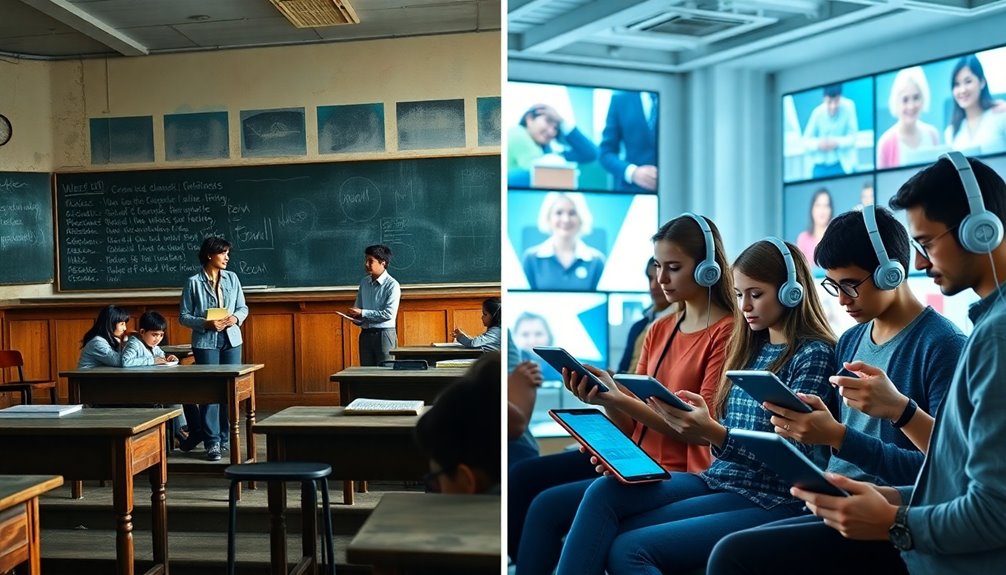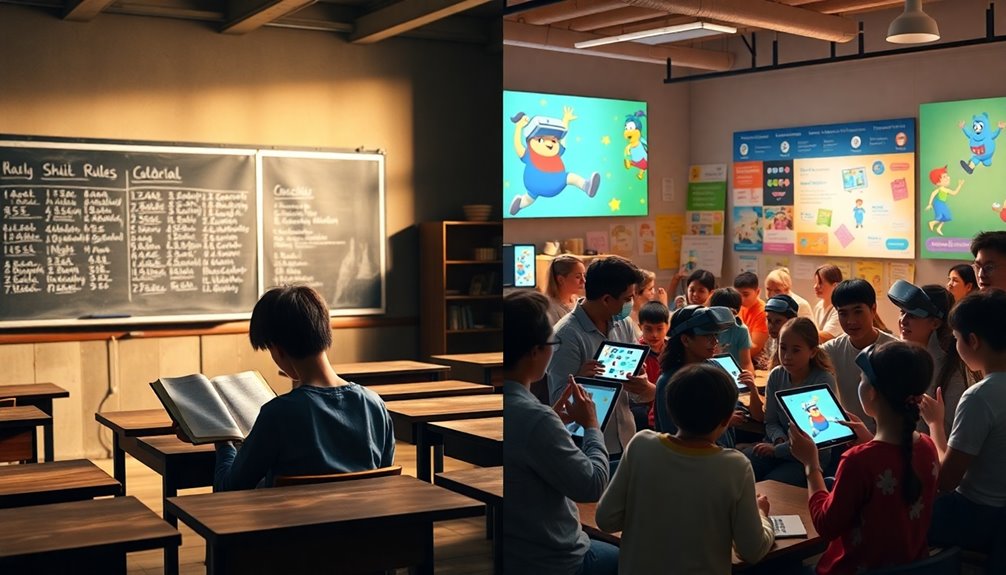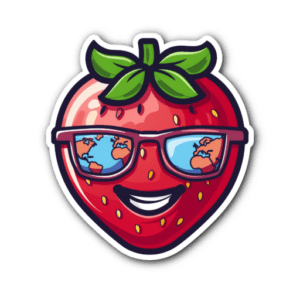Language learning has come a long way! Traditional methods focused on grammar and memorization, but now it’s all about real-life communication and using technology. Imagine chatting with a local while tasting their favorite dish abroad! You can use apps, podcasts, and even social media to connect with native speakers. With these modern approaches, you’ll not just learn a language—you’ll live it! Stick around to discover even more exciting ways to enhance your language journey!
Historical Overview of Language Learning Methods
When you plunge into the fascinating world of language learning methods, it’s like stepping into a lively historical timeline where each approach tells a unique story.
Immerse yourself in the vibrant history of language learning, where each method unfolds its own captivating narrative.
You’ll discover historical milestones that highlight major pedagogical shifts and the impact of cultural influences. Each teaching philosophy reflects societal changes, showcasing how learning environments adapt to linguistic diversity.
Educational reforms have shaped methods to enhance cognitive development, allowing learners to connect with historical texts in innovative ways.
As you explore these methods, you’ll see how they’ve evolved over time, creating diverse pathways for language acquisition. This journey not only enriches your understanding of language but also deepens your appreciation for the interplay between culture and communication in our global society, encouraging you to explore one destination at a time as you learn about different languages and cultures.
The Grammar-Translation Method: A Traditional Staple
When you think about traditional language learning, the Grammar-Translation Method often comes to mind.
It’s all about understanding grammar rules and translating texts, which can be both helpful and a bit dry.
Let’s explore its key principles, along with the advantages and limitations that can shape your language journey! Additionally, many language learners also seek travel guides to enhance their cultural immersion, enriching their overall experience.
Key Principles Explained
Imagine diving into a new language and uncovering its secrets, all while you explore vibrant cultures around the globe!
The Grammar-Translation Method focuses on reading and writing, letting you grasp grammar rules and vocabulary in a structured way. You’ll translate sentences and analyze texts, which sharpens your critical thinking skills.
While it may not offer the same cultural immersion as speaking with locals, it lays a solid foundation for understanding. You’ll be equipped to recognize patterns and meanings, making future conversations easier.
Picture yourself in a cozy café in Paris, confidently reading the menu or deciphering a book in its original language. This method’s principles pave the way for your exciting language journey!
Advantages and Limitations
While the Grammar-Translation Method may seem old-fashioned, it still offers some exciting advantages that can enhance your language learning experience. For starters, its traditional advantages include a solid focus on grammar and vocabulary, which can really help you understand the language structure.
However, you might face modern limitations like low learner engagement and a lack of cultural context.
On the bright side, resource accessibility is often high, and teaching flexibility allows for tailored approaches.
Still, assessment challenges can arise when measuring true conversational skills. Remember, motivational factors play a huge role in your success, so mix in some fun activities, like travel or cooking, to keep things lively and enjoyable!
Embrace this method, and you’ll find a solid foundation for your language journey!
The Direct Method: Immersion in Language
Have you ever thought about how amazing it would be to learn a language by jumping right into it?
The Direct Method focuses on natural communication techniques, helping you pick up vocabulary through real-life context.
Imagine chatting with locals at a bustling market or ordering food in a cozy café—it’s all about immersion and making connections! Additionally, incorporating traditional Italian recipes can enhance your language learning experience by connecting culinary vocabulary with cultural practices.
Natural Communication Techniques
When you plunge into a new language through immersion, it feels like stepping into a vibrant world where every word opens up new adventures.
Natural communication techniques make learning exciting and safe! Here are some immersive experiences to reflect on:
- Cultural exchanges: Engage with native speakers to share traditions and customs.
- Conversational practice: Regular chats boost your confidence and fluency.
- Role-playing activities: Act out real-life scenarios to enhance your speaking skills.
- Language games: Fun competitions make learning enjoyable and memorable.
Utilizing authentic materials like books and films along with peer interactions can deepen your understanding.
Don’t forget storytelling techniques; they create emotional connections and make the language come alive.
Embrace these methods, and you’ll navigate your language journey with ease and excitement!
Vocabulary Through Context
Imagine you’re strolling through a bustling market in Barcelona, the air filled with the scent of fresh churros and spices. As you chat with vendors, you’re immersed in the language, and that’s where contextual learning shines!
This method helps you pick up new words naturally, making vocabulary retention much easier. When you see, hear, and use words in context, they stick in your memory.
Want to know a secret? Try labeling items in your house with their names in Spanish! It’s a fun way to reinforce what you learn.
Audio-Lingual Approach: Emphasizing Listening and Speaking
The Audio-Lingual Approach, with its vibrant focus on listening and speaking, can truly transform your language learning experience! This method emphasizes active engagement, making it perfect for those who want to plunge into a new language.
Here are key components you should explore:
- Listening techniques to enhance your auditory skills.
- Speaking exercises that boost your confidence in conversation.
- Pronunciation practice to refine your accent through phonetic training.
- Conversational drills that encourage repetition strategies for better retention.
With immersive experiences, you’ll find yourself developing a strong foundation in active listening and language immersion. Additionally, many learners benefit from exploring last-minute travel deals that allow them to practice their new language skills in real-world settings.
Communicative Language Teaching: Focus on Interaction
If you’re enthusiastic to immerse yourself in a world where speaking and understanding a new language come alive, then you’ll love the Communicative Language Teaching (CLT) approach!
This method emphasizes interaction strategies that encourage you to practice in real-world scenarios. Imagine chatting with locals at a vibrant market or sharing stories with classmates in a cozy café—these experiences are all about collaborative learning and cultural immersion.
You’ll engage in group activities, role-plays, and discussions that make language learning feel natural and fun.
Whether you’re exploring the streets of Paris or traversing a bustling Tokyo, CLT prepares you to communicate confidently. Engaging in this approach can be enhanced by utilizing travel organization solutions that help you keep your learning materials and essentials neatly arranged while on the go.
Engage with this approach and watch your language skills flourish as you connect with diverse cultures around the globe!
The Emergence of Technology in Language Learning

As you plunge into the exciting world of language learning, you’ll quickly discover that technology has become your trusty sidekick.
With tools at your fingertips, you can dive deeper and learn faster. Here are some amazing tech advancements you’ll love:
- Virtual classrooms make learning interactive and accessible from anywhere.
- Language apps provide personalized lessons tailored to your pace.
- E-learning platforms offer vast digital resources and multimedia content for immersive experiences.
- Online communities allow for real-time language exchange and support from fellow learners.
Additionally, many learners now rely on top travel accessories to enhance their study abroad experiences and stay organized while immersing themselves in new languages and cultures.
Online Courses and Mobile Applications: A Modern Revolution
While immersing yourself in online courses and mobile applications, you’ll find yourself on a thrilling adventure that opens doors to new languages and cultures.
With online learning, you can explore interactive platforms that keep you engaged and motivated. Mobile apps offer accessibility benefits, letting you learn anytime, anywhere, making self-paced learning a breeze.
Imagine chatting with language communities or using digital resources like videos and games that make learning fun!
Plus, virtual classrooms connect you with teachers and fellow learners, creating a supportive environment. The multimedia content enriches your experience, helping you grasp the language more effectively. Additionally, you can enhance your learning journey with travel accessories for kids that keep children entertained during language immersion trips.
The Role of Social Media in Language Acquisition
Social media isn’t just for sharing memes and photos; it’s become a vibrant playground for language learners seeking to connect and grow.
Social media has transformed into an exciting space for language learners eager to connect and enhance their skills.
The social media impact on language acquisition is huge, providing access to diverse online language communities.
Here are four ways you can leverage social media for your language journey:
- Join Groups: Engage in Facebook or Reddit groups focused on your target language.
- Follow Language Influencers: Find YouTubers or Instagrammers who teach languages with fun tips.
- Practice with Native Speakers: Use platforms like Tandem or HelloTalk to chat with native speakers.
- Share Your Progress: Post updates on your learning journey, inviting feedback and encouragement from others.
Additionally, many language learners are utilizing sustainable practices by sharing resources that promote eco-friendly learning materials and tools.
Gamification and Interactive Learning Experiences

Ready to level up your language skills? Gamification and interactive learning experiences can turn studying into a fun adventure, making you more engaged and motivated.
Let’s explore how game-based learning, interactive tools, and creative practice methods can transform your journey into mastering a new language! Additionally, consider how flexibility in booking dates for language immersion trips can enhance your learning experience.
Game-Based Learning Benefits
Imagine diving into a world where learning a new language feels more like an exciting adventure than a chore!
Game-based learning taps into game mechanics that boost your learner motivation while making the process enjoyable.
Here’s why you’ll love it:
- Engagement: You’ll be actively involved, turning lessons into fun challenges.
- Instant Feedback: You’ll receive immediate results, helping you improve quickly.
- Safe Environment: You can make mistakes without fear, encouraging risk-taking.
- Social Interaction: You’ll connect with fellow learners, making language practice a shared adventure.
Interactive Tools and Techniques
Interactive tools and techniques can transform your language learning journey into an exhilarating quest!
Imagine diving into interactive language exercises that make practice feel like a game. These engaging activities not only boost your skills but also keep you excited about learning.
You can explore collaborative learning platforms that connect you with fellow learners around the globe. Working together, you’ll tackle challenges, share insights, and celebrate victories.
Plus, these platforms provide a safe space where everyone can learn without the fear of making mistakes.
So, whether you’re chatting with a partner or competing in friendly challenges, you’ll find that language learning can be both fun and fulfilling.
Get ready to initiate an adventure that makes every lesson memorable!
Engaging Language Practice Methods
While you’re on your language learning journey, incorporating gamification and interactive experiences can truly elevate your practice. Here are four engaging methods to try:
- Immersive storytelling: Immerse yourself in narratives that help you explore the language contextually.
- Role playing games: Step into characters and scenarios, making learning fun and memorable.
- Collaborative projects: Team up with peers for group tasks that enhance communication skills.
- Conversation clubs: Join like-minded learners to practice speaking in a relaxed setting.
These activities promote cultural exchanges and peer teaching, while multimedia resources can enhance your understanding.
Embrace language challenges that keep you motivated, and you’ll find your skills growing faster than you imagined.
Get ready to enjoy every moment of your learning adventure!
Personalized Learning and Adaptive Technologies
As you plunge into the world of language learning, you’ll find that personalized learning and adaptive technologies are transforming the way we approach mastering new languages.
Imagine a learning experience tailored just for you! With personalized feedback, your strengths and weaknesses are highlighted, helping you focus on what matters most.
Adaptive assessments adjust to your skill level, ensuring you’re always challenged without feeling overwhelmed. This safe, supportive environment encourages you to push boundaries and grow at your own pace.
Whether you’re practicing vocabulary or engaging in real conversations, these tools create a unique journey that invites exploration.
Comparative Effectiveness: Traditional vs. Modern Approaches
When you step into the domain of language learning, it’s fascinating to see how traditional methods stack up against modern approaches. Here’s a quick comparison:
- Traditional methods focus heavily on grammar and vocabulary.
- Modern approaches utilize blended learning, combining online tools with in-person classes.
- Cultural immersion allows you to experience the language in real-life contexts.
- Interactive technologies foster engagement and provide instant feedback.
While traditional methods build foundational skills, modern techniques often promote a deeper, more engaging experience.
Think about traveling to a new country where you’re surrounded by the language—nothing beats that!
Embracing both styles can enhance your learning journey, making it more effective and enjoyable.
Some Questions Answered
How Do Cultural Aspects Influence Language Learning Methods?
When you immerse yourself in a new culture, it’s like opening a treasure chest of language identity. Cultural immersion shapes your learning methods, making them richer and more meaningful, as you connect with the world around you.
What Are the Emotional Impacts of Language Learning?
Language learning can stir feelings like excitement or anxiety. You may face language anxiety, impacting your confidence. Embracing a new language can also strengthen your cultural identity, fostering connections with others and enhancing your sense of belonging.
How Do Age and Learning Styles Affect Language Acquisition?
Age factors and learning preferences considerably influence your language acquisition. Younger learners often absorb languages more easily, while older learners may benefit from structured methods. Adapting to your unique style can enhance your learning experience safely.
What Role Does Motivation Play in Language Learning Success?
Motivation’s essential for your language learning success. Intrinsic motivation drives your passion, while extrinsic rewards can enhance progress. Goal setting helps structure your journey, and social interaction makes learning enjoyable and engaging, boosting your confidence.
How Can Teachers Adapt Traditional Methods for Modern Students?
To adapt traditional methods for modern students, you can blend learning by incorporating digital resources. This approach creates a safe, engaging environment, allowing you to tailor lessons that resonate with today’s learners and their unique needs.







